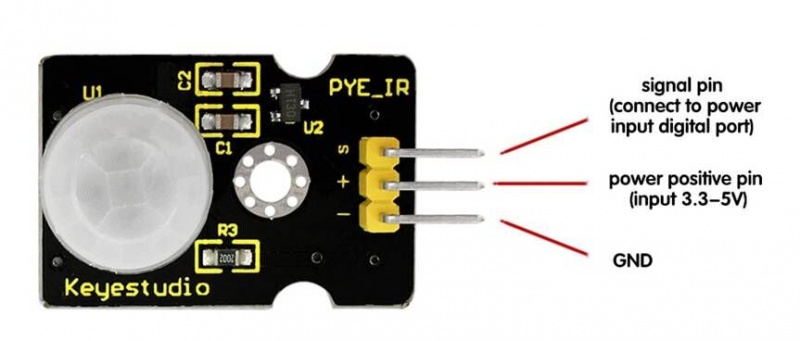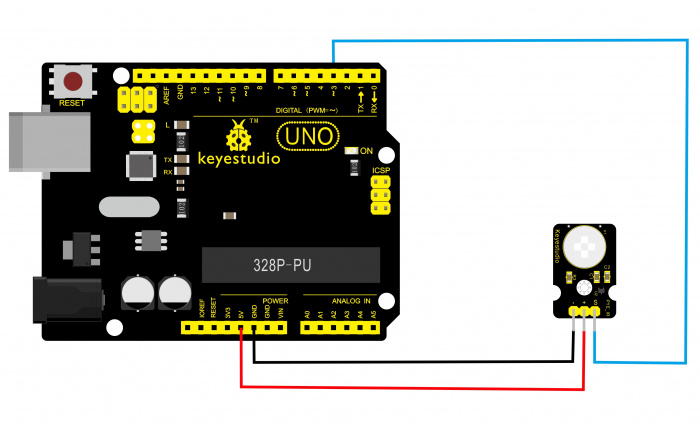Features
- Wide operating voltage range: DC 3.3V–18V
- Low static power consumption: 15µA
- High reliability
- Output time delay: 2.3–3s
- Can operate standalone or with microcontrollers (Arduino, Raspberry Pi, etc.)
- Output indicator LED (ON when HIGH)
- Detection angle: 100°
- Detection range: 3–4 meters
- Easy connection to analog circuits and microcontroller boards
Principle of Work
The PIR sensor detects changes in infrared radiation caused by moving objects. When a human passes in its field of view, the change from ambient to body temperature is converted to an output signal. Repeated triggers ensure reliable detection for continuous movement.
Pinout

| Pin |
Description |
| S |
Digital output (HIGH: 3.3V, LOW: 0V) |
| Power + |
Positive DC supply 3.3–5V |
| Power - |
Ground |
Applications
- Intruder alarms
- Entryway lighting
- Security lighting
- Hand dryers
- Automatic doors
Circuit
Connect the module's S pin to Digital 3 on the Arduino UNO, Power - to GND, and Power + to 5V.

Code Example
byte sensorPin = 3;
byte indicator = 13;
void setup() {
pinMode(sensorPin, INPUT);
pinMode(indicator, OUTPUT);
Serial.begin(9600);
}
void loop() {
byte state = digitalRead(sensorPin);
digitalWrite(indicator, state);
if(state == 1) Serial.println("Somebody is in this area!");
else Serial.println("No one!");
delay(500);
}
After Code Uploading
When motion is detected, the D13 indicator LED lights up and "Somebody is in this area!" is displayed on the serial monitor. If no motion is detected, the LED stays off and "No one!" is displayed.
Technical Details
| Parameter |
Value |
| Voltage |
3.3V–18V |
| Static Current |
<15µA |
| Logic Output |
3.3V / 0V |
| Delay Time |
2–3s |
| Sensing Range |
100° angle, 3–4 meters |
| Temperature |
-20 ~ 85°C |
| Output Indicator LED |
ON when HIGH |
| Pin Limit Current |
100mA |
| Dimension |
15mm x 15mm x 20mm |
Comparisons
For small footprint projects, alternatives include SR-602, HC-SR505, and AM312 sensors. The AM312 works at a lower voltage (2.7V) and offers longer delay times (8s), making it suitable for ESP8266 applications.
Features
- Wide operating voltage range: DC 3.3V–18V
- Low static power consumption: 15µA
- High reliability
- Output time delay: 2.3–3s
- Can operate standalone or with microcontrollers (Arduino, Raspberry Pi, etc.)
- Output indicator LED (ON when HIGH)
- Detection angle: 100°
- Detection range: 3–4 meters
- Easy connection to analog circuits and microcontroller boards
Principle of Work
The PIR sensor detects changes in infrared radiation caused by moving objects. When a human passes in its field of view, the change from ambient to body temperature is converted to an output signal. Repeated triggers ensure reliable detection for continuous movement.
Pinout

| Pin |
Description |
| S |
Digital output (HIGH: 3.3V, LOW: 0V) |
| Power + |
Positive DC supply 3.3–5V |
| Power - |
Ground |
Applications
- Intruder alarms
- Entryway lighting
- Security lighting
- Hand dryers
- Automatic doors
Circuit
Connect the module's S pin to Digital 3 on the Arduino UNO, Power - to GND, and Power + to 5V.

Code Example
byte sensorPin = 3;
byte indicator = 13;
void setup() {
pinMode(sensorPin, INPUT);
pinMode(indicator, OUTPUT);
Serial.begin(9600);
}
void loop() {
byte state = digitalRead(sensorPin);
digitalWrite(indicator, state);
if(state == 1) Serial.println("Somebody is in this area!");
else Serial.println("No one!");
delay(500);
}
After Code Uploading
When motion is detected, the D13 indicator LED lights up and "Somebody is in this area!" is displayed on the serial monitor. If no motion is detected, the LED stays off and "No one!" is displayed.
Technical Details
| Parameter |
Value |
| Voltage |
3.3V–18V |
| Static Current |
<15µA |
| Logic Output |
3.3V / 0V |
| Delay Time |
2–3s |
| Sensing Range |
100° angle, 3–4 meters |
| Temperature |
-20 ~ 85°C |
| Output Indicator LED |
ON when HIGH |
| Pin Limit Current |
100mA |
| Dimension |
15mm x 15mm x 20mm |
Comparisons
For small footprint projects, alternatives include SR-602, HC-SR505, and AM312 sensors. The AM312 works at a lower voltage (2.7V) and offers longer delay times (8s), making it suitable for ESP8266 applications.


